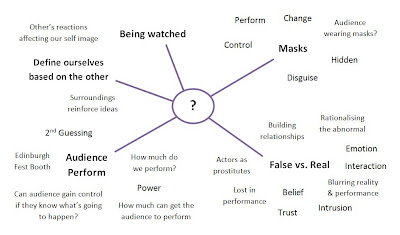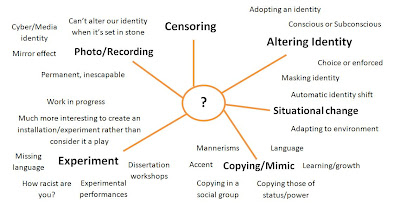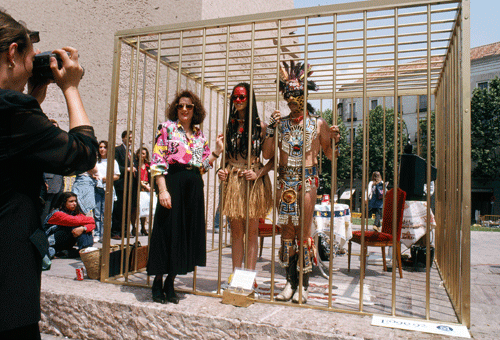A million possibilities.
Where to start?!
Sitting in our humble little circle as the other groups filtered out of the quietening CAPITAL studio, we decided the best way we were going to get the process started was to discuss what we each wrote in our essays. This told us what each of us were interested in exploring further and what subjects we wanted to avoid like the plague after having written thousands of words on it.
A key line of thought that arose from our description of our essays was our shared interest as performance and identity as something that was perplexing and troubling, with a want to revaluate the very foundations of them, rather than picking a specific grand, clichéd theme that could overpower our work. In other words, as a group the feel was that before we could start making sweeping statements about identities of race, sexuality, class etc, we felt a need to better understand the way we ourselves were aware of identity and its very composition.
To make the discussion useful, I also started a brainstorm/spider diagram to see how our interests and discussion was related. The first, in purple, was our first more of our general ideas. The second, in orange, was when we tried to distill our ideas a bit more, branching of from the themes and ideas we'd been talking about.
Click on the images to enlarge
One of the key sources that kept coming up in our conversation, the sources of our excitement, interest and intrigue, was that of performative experiments and performance art. By this I mean experiments that explored and challenged our ideas of identity through a means of performance or specifically including experiment in the performance, not necessarily having a clear set out narrative to tell but using performance as a means to explore something. I also felt this approach fits best with the timescale of the project and that it was a 'work in progress' piece, as if the means of the performance was to explore something and learn something new then we would hopefully focus more on the core of the project rather than creating a polished final piece, something that as a bit of a perfectionist and involved in theatre production would be easy to get distracted by.
This stemmed originally from the 'The Couple in a Cage: Guatinaui Odyssey' experiment we watched in class last term, not particularly for any statements it made on race, class or society as such, but in the way it explored the audience's reaction, presenting itself as being one thing, having a motive on the surface, but at the same time concealed another and even discovered things about their audience they didn't expect.
Coco and I lived for three-day periods in a gilded cage, on exhibition as 'undiscovered Amerindians' from the (fictional) island of Guatinau (Spanglishization of 'what now'). I was dressed as a kind of Aztec wrestler from Las Vegas, and Coco as a Taina straight out of Gilligan's Island. We were hand-fed by fake museum docents, and taken to the bathroom on leashes. Taxonomic plates describing our costumes and physical characteristics were displayed next to the cage.
As it travelled from site to site, it became more stylised, staged, and whimsical. Sadly, over 40% of our audience, no matter where we were, believed that the exhibit was real (at least during their first visit) and did not feel compelled to do anything about it.
Gomez-Pena Guillermo
For some, the audience believed what they saw, that the larger than life actors where in fact an newly discovered race, to such an extent that some happily paid to have their photo with them. But even those who weren't so gullible, seemed to have an even stronger reaction of disgust and confusion at the thought of being duped or led on, not so much as being on the same par with the creators in understanding a message they want to portray, but a sense of feeling attacked or ridiculed. Their reaction also varied according to their location or environment, from the trustworthy museum to the public park.
This inspired us as a group to research into experiments and instillations. Rather than creating a performance that showcased a certain message to the audience, preaching a certain theme or having a fictitious narrative to make up our theme, we were more interested in using the active audience and their experience of the piece to discover something new and allow the audience to discover for themselves what they were experiencing.
Task for next meeting: To research into performative experiments, whether in a drama context or not, that relate to the questioning of identity and the audience's relationship with the performance.
Texts & Links:
- Guillermo, Gomez-Pena, The New World Border: Prophecies, Poems & Loqueras for the End of the Century, City Lights Books, 1996
- Coco Fusco, 'The Couple in a Cage', http://www.thing.net/~cocofusco/images/couplecage/cage_web01.gif


